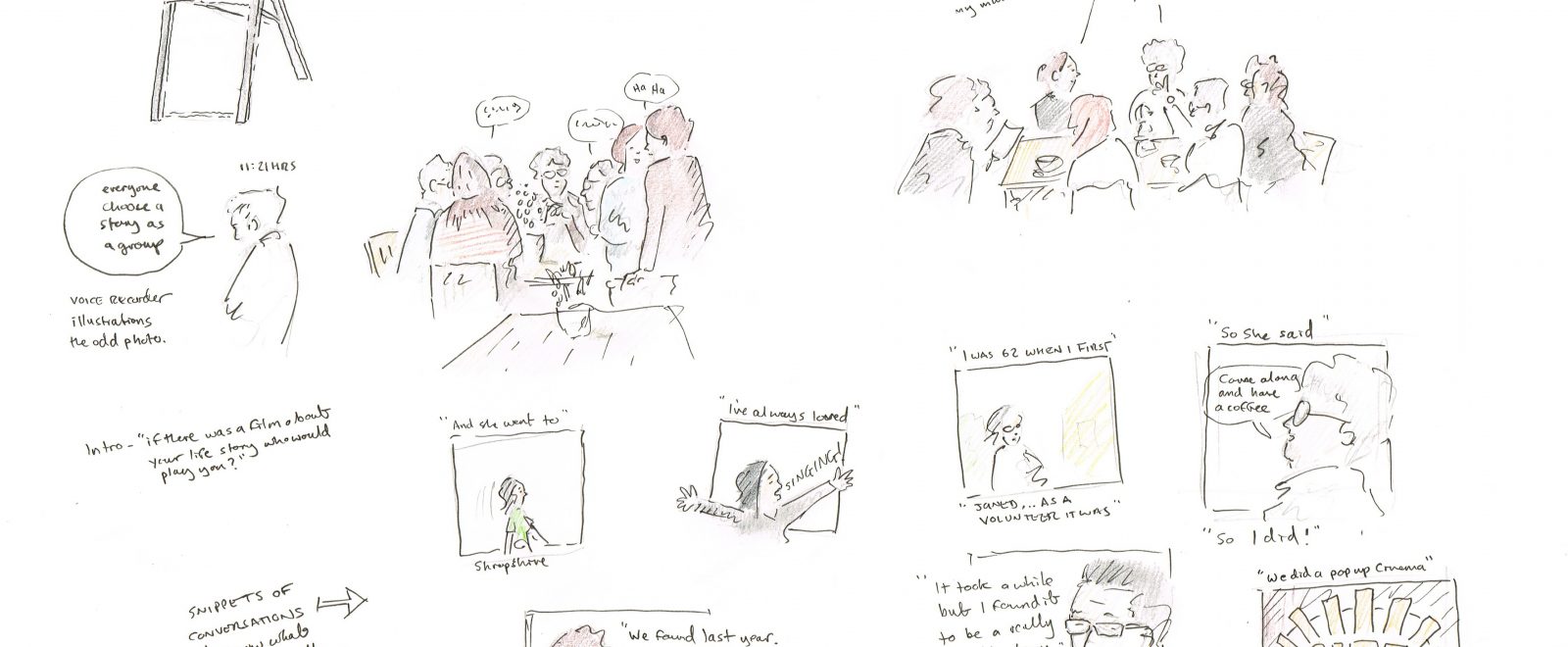
The Art of Community Building
In this blog post, illustrator Karl Whiteley (who587.com) shares his reflections on working with Barnwood Trust and Gloucestershire residents to help bring stories about connected communities to life.
The Barnwood Trust first asked me to sit in as an illustrator for a Story Catching event in December 2014. I think it was the first one that they held. About 30 members of the Tewkesbury community gathered together to discuss what the notion of community meant to them. They talked jubilant stories – stories of how they had helped others or benefited themselves from within their community.
It was a new experience to most of the people there. The room was broken down into groups and asked to take part in discussions for about 45 minutes. Not knowing exactly what to do, I sketched as they talked and scribbled down little snippets of conversation that wafted over to where I was sitting. I got a general feel for the vibe while trying to record the sights and sounds. This is called observational drawing or reportage. The groups got into it quickly – people like talking and people like hearing stories, so nerves were soon forgotten.
Each group was then asked to choose their favourite story which was to be told to the entire room. Once the chairs were put into a circle the first person began their story. It’s a brave thing to stand up and do that if your not used to it; to speak in front of a group, sometimes in a frank and personal way about their own feelings, thoughts and actions.
I recorded the stories in a loose comic strip format. Using an A3 sheet of paper for each one I quickly drew the panels and filled them with words and images as the storyteller spoke. This worked well in producing a verbatim type narrative flow, not getting down every single word, but also not getting time to edit what was being said. I did this for all four stories. Then the session ended and I took the roughs away.

Once home I went over the pencil in ink and coloured the first story in, I sent a scan to the Barnwood Trust. They liked it and asked for the others to be coloured.
Since then, I have attended about six or seven events. The atmosphere has been different at each one with varying venue size and amounts of participants. So the approach I’ve taken at each event has differed accordingly. When it’s a small venue with less people it can feel a bit inappropriate to sit and sketch, so I join in with the discussions. The sessions are recorded so I can listen again at home transcribe them and sketch the story layouts.
After those initial four stories I have employed my standard process in creating the stories. Using whatever gathered material I’ve had (sketches, recordings & notes) I lay out a pencil rough.
The words are the first thing to work on – editing out the less important information while being careful to maintain the rhythm and beat of the story, plus spacing sentences out and ensuring breaks in the narrative are in the right place so it reads with flow. Then images get sketched in. This is where a new dimension is added, bringing it alive with that combination of pictures and words.
Once it’s all pencilled in (Fig1) I email it over for approval. There’s always alterations to be made, slight word changes and fixes in panel layout. Once done I move onto the ink stage (Fig 2), going over the pencil and adding finer details. This updated version gets emailed for approval. After getting a thumbs up I start the colouring stage (Fig 3) using Photoshop using the same palette every time. Then it’s done.

Comic strips or ‘Sequential Narrative’s as they are now often called, are an ideal way to communicate stories of an intimate and personal nature. Visually appealing, friendly and accessible. The addition of pictures can help bring the words to life in a way that they can’t always do themselves.
It’s been an very enjoyable experience for me working alongside the Barnwood Trust as an illustrator on these exercises. It’s been eye opening. I’ve learnt a lot about people, human nature and myself. I now know that building a ‘community’ is not just about bricks, mortar, tarmac, parks, schools and shops. There’s quite a bit more to it than that.
Karl Whiteley (who587.com)